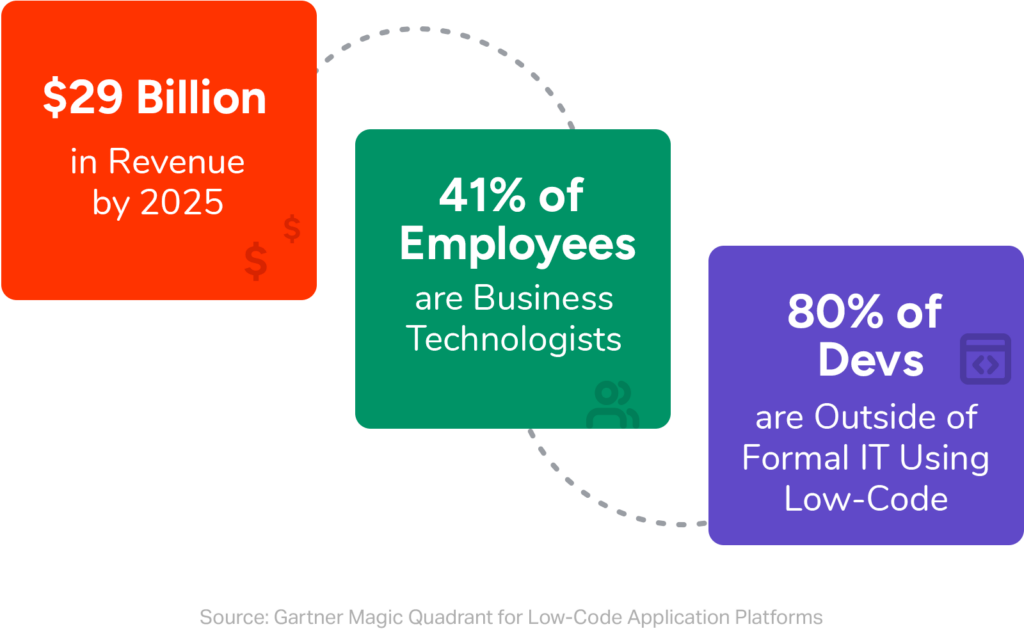

Low-Code vs Traditional Development: Cost-Benefit Analysis for CIOs
CTOs, CIOs, Dev Team Leaders and other high-level executives must make informed decisions when choosing between low code vs. traditional development. And this article will compare these two approaches, focusing on different tradeoffs, advantages, criteria, and more.
It’s an increasingly digital world, and businesses strive to remain as agile and competitive as possible. But to do that, first and foremost, they need to optimize their resources to deploy solutions faster. And because speed is essential in every software development process today, organizations are racing to respond to the demand for faster software development. Which leaves them with two options: low-code vs traditional development.
To choose between these two, CTOs, CIOs, Dev Team Leaders, and other high-level executives must consider various tradeoffs like speed, cost, business agility, etc. But it comes as no surprise that with all the advantages that low code offers, it has gained significant traction. Low-code statistics by Gartner even show that “by 2025, 70% of new applications developed by organizations will use low-code or no-code technologies, up from less than 25% in 2020.” And yet, the decision must be supported by practical financial and strategic considerations.
That’s why I will outline key differences between low-code vs traditional development, various use cases, and other factors to consider when determining the best approach for your business.
Low-Code vs Traditional Development Comparison
According to the CIO’s Guide to Prioritizing, Driving and Scaling Innovation by Gartner, “successful innovations align with business goals, cater to market demands, ensure scalability, uphold financial viability and adhere to legal standards, fostering sustainable growth. CIOs, with their role in overseeing technology usage and development, occupy a unique position among CxOs to drive and scale innovation, particularly in an era where technology drives most innovations.” This is why you must understand the differences between using a low-code platform vs traditional development.
Low-Code Development
Tools like App Builder provide a visual interface, drag-and-drop app-building experience, pre-built UI components for popular web frameworks, templates, themes, code generation, instant code preview, AI capabilities, data binding, CRUD, BI analytics, and other automation tools for rapid app development. Best for simple to medium complexity projects.Traditional Development
Involves creating each feature and data structure manually through custom code. This way developers can implement unique functionalities and get full control over the app’s behavior. Best for complex applications.Low-Code Development
Rapid – automating every process from design to code, so it accelerates app development up to 10x faster. This reduces development cycles to days and weeks instead of months.Traditional Development
Slower – can take considerably longer (up to a year), depending on the app complexity, the amount of manual coding, design, testing, debugging, and deployment.Low-Code Development
It comes with pre-built UI controls, templates, themes, etc., but they can be customized to meet app requirements and branding. Some low-code platforms offer SDKs to extend or customize the platform. This allows developers to build custom features that go beyond what the platform natively supports, making the platform more flexible for unique business requirements.Traditional Development
Ensures deep and unlimited customization, with ability to build tailored apps from scratch. SDKs are often used in traditional development to integrate third-party libraries or services, enhancing customization and functionality.Low-Code Development
More cost-effective, with low upfront costs, and it takes fewer developers and less time.Traditional Development
More expensive, with high upfront costs, expensive maintenance, and requiring a bigger budget and technical team.Low-Code Development
Built on scalable architectures that can accommodate the growth of apps over time. They enable horizontal and vertical scaling, ensuring that applications can handle increased user loads, data volumes, and transaction rates.Traditional Development
Although there are no constraints on the complexity or size of the apps, traditional coding may require allocating and hiring more programmers for certain projects. Still, this approach may not be as agile when the organization requires RAD and more frequent iterations.Low-Code Development
Optimized for performance so it can handle bottlenecks such as database queries, user interface rendering, third-party API interactions, and more.Traditional Development
Optimized for performance but can handle intensive data processing and complex functionalities more efficiently.Low-Code Development
Easier maintenance, typically with automatic updates from the platform provider, without worrying about upkeep.Traditional Development
More complicated maintenance processes as it requires dedicated teams for updates and fixes.Low-Code Development
Optimized for security with built-in security features that adhere to industry compliance, security protocols, and data protection.Traditional Development
Full control over security, allowing custom implementations to comply with industry standards, security protocols, and data protection.Low-Code Development
Easier for non-developers, junior programmers, and citizen developers as many operations are automated. It requires less coding expertise and manual code.Traditional Development
Steeper learning curve, requiring deep knowledge of frameworks, languages, and software engineering principles.Low-Code Development
The pre-designed UI components may limit the flexibility of complex UX customization but are sufficient for most common use cases.Traditional Development
Full control over custom UX design, allowing for tailored UX.Low-Code Development Use Cases
Although there are similarities between low-code development vs traditional, they remain two distinct approaches with differences in terms of when and why they are implemented. Tools like App Builder are great for:
Resource Allocation & Business Process Automation
In one of the most recent surveys by Reveal, results indicate that “more than a third (40%) of software industry professionals are facing increased customer demands and 39% are working with limited resources (lack of budget, unable to maintain software).” So, tackling resource constraints and developer shortages is crucial for businesses that want to innovate. Development teams frequently manage multiple projects or tasks simultaneously, leading to inefficient resource allocation, missed deadlines, compromises in the app quality, and increased expenses.
Business of Apps, for example, estimates that developing a simple app with a basic UI and general features costs between $5,000 and $50,000, with a development timeline of two to four months. For medium-complexity apps, the cost ranges from $50,000 to $120,000, and development can take up to six months. On the other hand, complex app projects may require nine months to a year to complete with $100,000-$133,000 in expenses.

However, low-code tools can be the ideal solution when CIOs want to optimize a team’s capacity, business dynamics, and costs. The Total Economic Impact (TEI) study conducted by Forrester points out that organizations can save up to 70% in development costs compared to traditional development methods. This only proves that low code eliminates time-consuming, costly, and repetitive tasks and allows citizen developers and less experienced programmers to either create simple UX, build MVPs (Minimum Viable Products), or automate specific processes like approvals or workflows.
Keeping Pace With Market Trends & Eliminating Tech Debt
There’s a constant need to innovate and improve business processes to stay competitive. So, organizations must respond and adapt to business and market changes and provide teams with the right tools. What’s more, scaling applications without low-code tools can accumulate technical debt, such as poorly structured code, outdated dependencies, and undocumented workarounds. Technical debt hampers long-term scalability, maintainability, and extensibility, as executives must dedicate time and effort to address accumulating overheads and prevent future issues.
Low-code platforms, then, are great for rapid prototyping, development, and deployment of applications, allowing users to iterate on ideas and respond to market demands quickly. By streamlining the development process and reducing time to market, low-code platforms actually facilitate agility and responsiveness to changing market needs.
Legacy System Modernization & Integration
Legacy system modernization is a significant challenge for many companies, especially as technology evolves and businesses need change. Organizations seeking to modernize legacy systems, then, can use low-code platforms to integrate older systems with newer technologies because they offer built-in connectors and APIs that facilitate the process.
Apps That Can Be Built Faster & With Less Resources
Low-code platforms are ideal for building UI screen layouts, internal tools such as employee portals, HR systems, project management tools, CRM systems, or creating customer-facing applications, such as customer portals, self-service dashboards, and web forms.
Traditional Development Use Cases
When it comes to traditional development, it is more suitable in areas where complexity and customization are key and budget is not a problem.
Custom Development Expertise & Long-Term Projects At Its Core
Traditional development is necessary when your business and projects need highly specialized coding expertise. It ensures full control over the tech stack, performance optimization, and compliance with business logic and specific needs. There are no limits on feature flexibility.
Cutting-Edge Innovation and Extensive Customization
Traditional development could be the better option when looking for a strategic competitive advantage. It offers deep customization and high levels of flexibility that low-code platforms may not be able to match. Optimized for heavy data loads and complex functionalities, traditional development allows organizations to create highly tailored solutions that address business and integration requirements.
Aligning Long-Term Goals & Continuous Improvement
Traditional development may be necessary for core systems that must align with long-term goals and comply with engineering principles and regulatory requirements. And with the deep know-how of frameworks, it can easily support projects that explore new opportunities and know no boundaries in terms of functionalities and UX since developers have full control over the code.
Apps That Can Be Built With Complexity In Mind
Traditional coding is better suited for building large-scale and mission-critical apps like CRMs and financial systems, core banking apps, retail platforms, ERPs, and others where performance, scalability, and ability to handle massive traffic are critical.
How To Combine Low Code With Traditional Development
It’s not always low-code vs traditional development. Some companies opt for a hybrid development model, using low-code platforms like App Builder and traditional development. Establishing this approach lets them balance speed, flexibility, expenses, and human expertise.
In the best-case scenario, CIOs can leverage low code to:
- Boost the productivity of teams
- Empower citizen developers and less experienced developers
- Build simpler apps, forms, dashboards, and custom interfaces quickly
- Automate repetitive tasks
Meanwhile, traditional development can be applied to:
- More complex back-end integrations and custom business logic
- Mission-critical modules
- Applications that require advanced scalability
- Out-of-the-box functionalities
It’s a win-win situation.
Which Approach is Right for Your Business?
To help you determine which one to choose between low-code vs traditional development, consider the following factors and questions:
Complexity of the Project
What functionalities and integrations does the project require? How complex is the app? Is it necessary to have coding from scratch or can existing templates adapt to the needs? Is the app expected to scale? Are there going to be frequent updates?
Budget and Resources
What is the budget for the project? Have you estimated the expected additional costs for maintenance, planned updates, etc.? How many developers do you need? Can the costs be reduced through rapid prototyping or automation of repetitive tasks?
Team Expertise
What is the development team’s current technical expertise? Are their skills enough to build the project? Do your team’s resources need to be optimized? How much training will the team require if you go with low code? Do you require detailed monitoring and full control of design-to-code processes?
Wrap-Up & Key Article Takeaways
If there’s one thing that businesses are doing today, it’s fighting the pressure to innovate faster with cost-efficient practices. Accomplishing these objectives largely depends on the choice businesses make – whether relying on low-code vs traditional development. Each approach offers distinct advantages, and understanding their best use cases is critical to making the right decision.
- For CIOs, CTOs, and other executives, the cost-benefit of low-code development is clear when the primary business goals are speed, agility, and cost-efficiency.
- Traditional development is more suitable as an option for complex or highly customized applications.
- A basic app can cost from $5,000 to $50,000, requiring two to four months to be built.
- Medium-complexity apps cost $50,000-$120,000, and development can take up to six months.
- Complex app projects can span from nine months to a year to complete, with costs ranging between $100,000 and $133,000.
- Ability to leverage low code to tackle mundane and repetitive tasks, freeing up time to work on the more customizable parts of the app.


